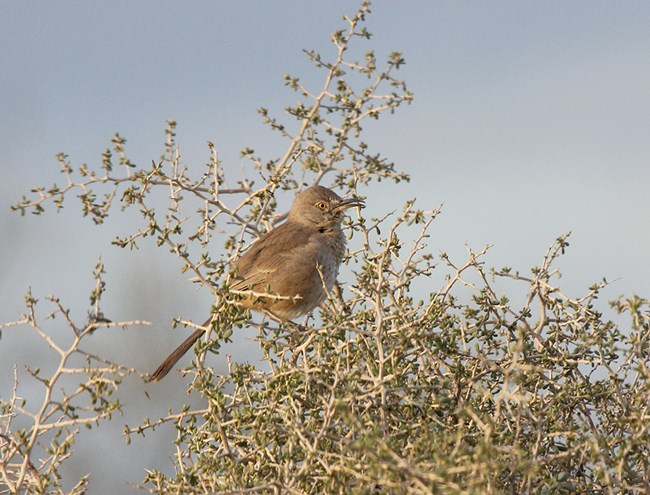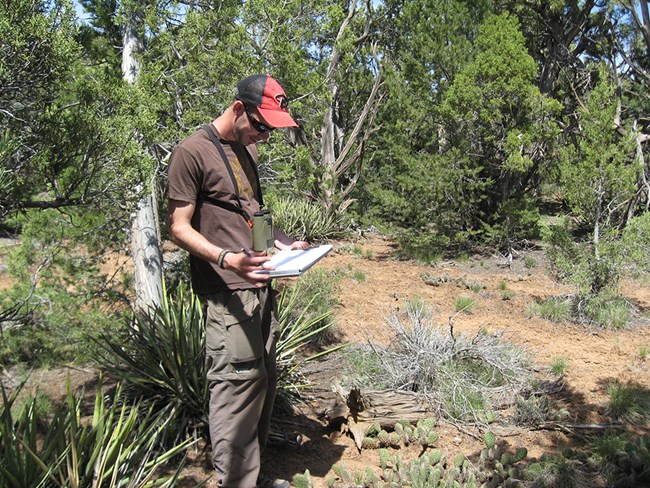
Dominic Sherony. Creative Commons license: https://creativecommons.org/licenses/by-nc/2.0/legalcode.
SCPN Monitoring Sites Webmap (NPS staff only)
Bird communities are composed of numerous species. Because they are mobile, relatively short-lived, and have specific habitat requirements, birds are sensitive to environmental disturbances. This makes them good indicators of ecosystem health. Long-term monitoring of birds can provide a record of the effects of changes in ecosystem conditions that might otherwise be difficult to detect.
Through a partnership with Northern Arizona University, the Southern Colorado Plateau Network (SCPN) is monitoring bird communities associated with specific habitats in selected network parks. Habitat-based bird monitoring will help to identify associations between bird communities and habitat conditions that can be linked to key drivers and stressors in the ecosystem. In addition, SCPN’s bird monitoring study sites overlap with the network’s integrated upland monitoring sites. The data collected about vegetation structure and soils can add to our understanding of changes in specific habitat conditions that affect bird communities.
Bird communities in the Southwest face a variety of threats. Changes in vegetation structure and insect abundance brought on by climate change may disrupt habitat use and the timing of migration. The spread of invasive exotic plants and land-use practices, such as livestock grazing and urban development degrade habitats necessary for bird survival. Furthermore, large-scale catastrophic fires have destroyed habitat and transformed large sections of forest in the wake of wildfire suppression during the 20th century. Diseases such as West Nile virus and avian influenza are additional stressors to birds.

NPS / SCPN
Monitoring Objectives
- Determine status and trends in species composition and abundance of breeding bird communities associated with selected upland and riparian habitats in SCPN parks.
- Improve our understanding of breeding bird habitat relationships by correlating changes in species composition and relative abundance and density with changes in specific habitat variables.
Vital Signs and Metrics
SCPN parks have identified 2 vital signs and associated metrics for this project:
1. Birds
-
Species abundance
- Species distribution
2. Habitat condition
-
Tree basal area
-
Sapling density
-
Vegetation cover by functional group
- Canopy closure
Monitored in These Parks and Habitat Types
- Bandelier National Monument - mixed conifer forest
- Canyon de Chelly National Monument - riparian
- Grand Canyon National Park - mixed conifer forest and pinyon-juniper woodland
- Mesa Verde National Park - pinyon-juniper woodland
- Petrified Forest National Park - grassland/shrubland
- Wupatki National Monument - grassland/shrubland
Monitoring Project Status
Bird communities are monitored every three years in specific ecosystems in six SCPN parks. Bird community monitoring in SCPN parks began in 2007. The Habitat-Based Bird Community Monitoring Protocol for the Southern Colorado Plateau Network was published in September 2015.
Project Contact
Harrison Jones, Avian Ecologist
Reports and Publications
Holmes, J. A., M. J. Johnson, C. L. Lauver, J. R. Norris, A. E. C. Snyder, and L. P. Thomas. 2015. Habitat-based bird community monitoring protocol for the Southern Colorado Plateau Network. Natural Resource Report NPS/SCPN/NRR—2015/1041. National Park Service, Fort Collins, Colorado.
Periodically, we publish reports on each vital sign that describe what we are learning in the field. These monitoring reports are more in-depth than resource briefs and include data analysis and a discussion of our findings. Our monitoring reports provide the most recent published findings from our field work.
Source: NPS DataStore Saved Search 3264. To search for additional information, visit the NPS DataStore.
Last updated: February 6, 2025
